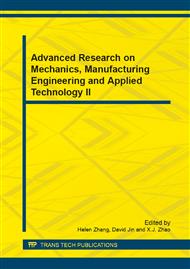[1]
J H Yun, D K Choi, H Moon: Chemical engineering science Vol. 55 (2000), p.5857.
Google Scholar
[2]
X Liu, R Chen, R Weng, et al. : Functional Materials Letters Vol. 5 (2012).
Google Scholar
[3]
P M Alvarez, F J Beltran, V Gomez-Serrano, et al. : Water research Vol. 38 (2004), p.2155.
Google Scholar
[4]
C Moreno-Castilla, J Rivera-Utrilla, J P Joly, et al. : Carbon Vol. 33 (1995), p.1417.
Google Scholar
[5]
S Román, B Ledesma, J F González, et al. : Journal of Analytical and Applied Pyrolysis Vol. 103 (2013), p.201.
Google Scholar
[6]
M Goto, N Hayashi, S Goto: Environmental science & technology Vol. 20 (1986), p.463.
Google Scholar
[7]
P Canizares, J Lobato, J Garcia-Gomez, et al. : Journal of applied electrochemistry Vol. 34 (2004), p.111.
Google Scholar
[8]
X Liu, R Weng, Z Chen: Acta Scientiarum Naturalium Universitatis Sunyatseni Vol. 48 (2009), p.2.
Google Scholar
[9]
H Zhang, L Ye, H Zhong: Journal of Chemical Technology and Biotechnology Vol. 77 (2002), p.1246.
Google Scholar
[10]
R Berenguer, J P Marco-Lozar, C Quijada, et al. : Carbon Vol. 48 (2010), p.2734.
Google Scholar
[11]
J F González, J M Encinar, A Ramiro, et al. : Industrial & engineering chemistry research Vol. 41 (2002), p.1344.
Google Scholar
[12]
R V Shende, V V Mahajani: Waste Management Vol. 22 (2002), p.73.
Google Scholar
[13]
F Salvador, N Martin-Sanchez, M J Sanchez-Montero, et al. : The Journal of Supercritical Fluids (2012).
Google Scholar
[14]
C S Tan, D C Liou: Separation Science and Technology Vol. 24 (1989), p.111.
Google Scholar
[15]
A Dehdashti, A Khavanin, A Rezaee, et al. : Turkish J. Eng. Env. Sci Vol. 34 (2010), p.49.
Google Scholar
[16]
F K Yuen, B H Hameed: Advances in colloid and interface science Vol. 149 (2009), P. 19.
Google Scholar
[17]
M Nüchter, B Ondruschka, W Bonrath, et al. : Green chemistry Vol. 6 (2004), p.128.
Google Scholar
[18]
J Sun, X Z Liu , L Peng. Advanced Materials Research Vol. 675 (2013), p.289.
Google Scholar
[19]
J A Menéndez, A Arenillas, B Fidalgo, et al. : Fuel Processing Technology Vol. 91 (2010), p.1.
Google Scholar
[20]
K E Haque, P D Kondos, R J C MacDonal: U. S. Patent CA Vol. 242 (2008), p.4.
Google Scholar
[21]
C Y Cha , C T Carlisle: Journal of the Air & Waste Management Association Vol. 51 (2001), p.1628.
Google Scholar


